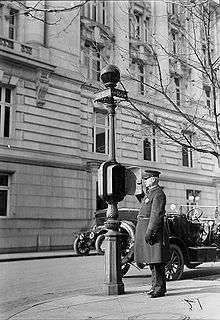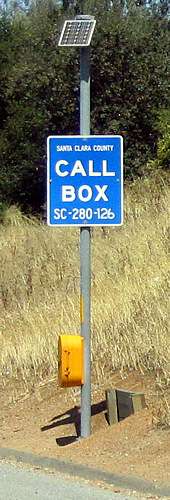Callbox

A call box or callbox is a (usually metal) box containing a special-purpose direct line telephone or other telecommunications device, which has been used by various industries and institutions as a way for employees or clients at a remote location to contact a central dispatch office.
Uses
Police and taxicab dispatching
Some taxi companies used callboxes before the introduction of two-way radio dispatching, as a way for drivers to report to the dispatch office and receive customer requests for service. Taxi callboxes would be located at taxi stands, where taxis would queue for trips.
Also before the introduction of two-way radios, some police agencies installed callboxes or "police boxes" at street locations as a way for beat officers to report to their dispatch office. Before the development of emergency telephone numbers and the proliferation of mobile phones, some firefighting agencies installed callboxes at various street locations, so that a pedestrian or driver spotting a fire could quickly report it.
Retail
A growing number of retailers use call boxes in their stores as a way for shoppers to summon service (Shopper Call Box) as well as for store employees to summon assistance (Director Call Box). Retail call boxes are generally wireless devices that communicate to in-store communication devices via radio frequency (303 MHz) or through 802.11 networks.

Motorist aid
Call boxes also exist at regular intervals along the sides of many highways and rapid transit lines around the world, where drivers or passengers can use them to contact a control centre in case of an accident or other emergency. Such call boxes are often marked by a blue strobe light which flashes briefly every few seconds. Boxes in remote areas often now have solar cells to power them.
U.S. highways with callboxes include most of the major highways in California, Florida's Turnpike and Interstate 185 in Georgia. Rather than a telephone, these devices simply have four buttons to push: blue for accident or other emergency (send police/fire/medical), green for major service (mechanical breakdown, send a tow truck), black for minor service (out-of-gas or flat tire), and yellow for cancel. Roads in other places may have voice call boxes, though these are more expensive, and must either be wired long distances, or rely on spotty rural mobile phone service.
Many cellular callboxes in California now include a TTY interface for hearing impaired users.

Call boxes have the advantage that their location is immediately known, while mobile phone users in trouble do not necessarily know where they are. For example, in California a cellular call to 911 connects to CHP, whereas a callbox will connect to a dedicated regional answer center. The DTMF ANI or caller ID from the callbox will be used to display callbox sign number and location on the CAD system.
Emergency callboxes can also have a secondary function as an RTU. Experimental systems deployed around Sacramento, CA (Sutter County Smart Call Boxes) were used to connect fog sensors and CCTV using the cellular transceiver within the callbox.
Decline in usage
In California, freeway callboxes were used about 98,000 times in 2001. That number dropped by 80% to 20,100 times in 2010, or about 1 call per box per month. The cost of callboxes for the Service Authority for Freeways and Expressways (SAFE) program in the San Francisco Bay area is $1.7 million annually.[1]
The State of Florida previously had callboxes installed at one-mile intervals along all its interstate highways as well as the Florida's Turnpike. These boxes were all removed by 2014 after a 65-percent decrease in usage over an eight-year period, in line with increased mobile phone usage. The boxes were costing the state roughly $1 million per year to keep operational.[2]
Safety
On many North American college and university campuses today, callboxes are installed at various locations around campus so that students, staff, or visitors can contact campus security in case of an emergency. Often, these are voice call boxes using a mobile phone service, and solar-powered so no wiring need be extended to the middle of a parking lot or other remote location. Thus, they can function during a power outage if the cell site is still powered.
Wireless call boxes
Call boxes may be wired or wireless. Wireless systems use radio frequencies in the VHF or UHF business band radio spectrum. Many callboxes can be programmed to be compatible with virtually any brand of VHF or UHF business band portable or fixed-base radio. Many in the United States require an FCC license, but some are certified for use on special FCC license-free business frequencies.
If the required distance is greater than the range of the wireless call box, an external antenna can extend the range. In the FCC-license frequency range, radio repeaters can extend this range even more.[3]
A wireless call box that runs on solar power can be truly wireless since no power lines need be run to it .
History
In the United States, the Gamewell Company of Newton, Massachusetts manufactured fire alarm call boxes beginning in the 1880s.[4] These would telegraph a location code to the central firestation when a lever was pulled in the box.[5]
Although it is difficult to determine when and where the earliest highway emergency phones were developed, undoubtedly one of the earliest examples were the freeway phones developed in Western Australia in 1966. This system was developed by Alan Harman, an employee of a Western Australian security firm, Central Station Security Company, Electronic Signals Pty Ltd, who came up with the idea after reading of a pile-up on the Kwinana Freeway. The newspaper article mentioned that assistance had been difficult to provide to those involved in the pile-up. The system Harman envisaged was a series of telephone units in a box on a short post, spaced at 160 metre intervals Perth’s freeways. Picking up the handset would trigger an alarm in the Main Roads control centre and police, fire or ambulance could then be determined by the caller. Harman developed the system with the approval of the Main Roads Commissioner and Chief Engineer, by adapting the existing design of communication facilities used at the security firm in which he worked.[6]
See also
References
| Wikimedia Commons has media related to Call boxes. |
- ↑ Cabanatuan, Michael (May 1, 2011). "Highway call boxes becoming obsolete". San Francisco Chronicle. Retrieved March 19, 2013.
- ↑ Morelli, Keith (October 17, 2013). "Florida dismantling call boxes along interstates". The Tampa Tribune. Retrieved March 10, 2016.
- ↑ "Wireless Call Box System Facts"
- ↑ "Gamewell FCI"
- ↑ Sweeney, Emily (January 27, 2008). "No cause for alarm". Boston Globe.
- ↑ Humble beginnings for freeway phones (July 1998). Western Roads: official journal of Main Roads Western Australia, 21(2), p.18. Perth: Main Roads Western Australia, 1998.